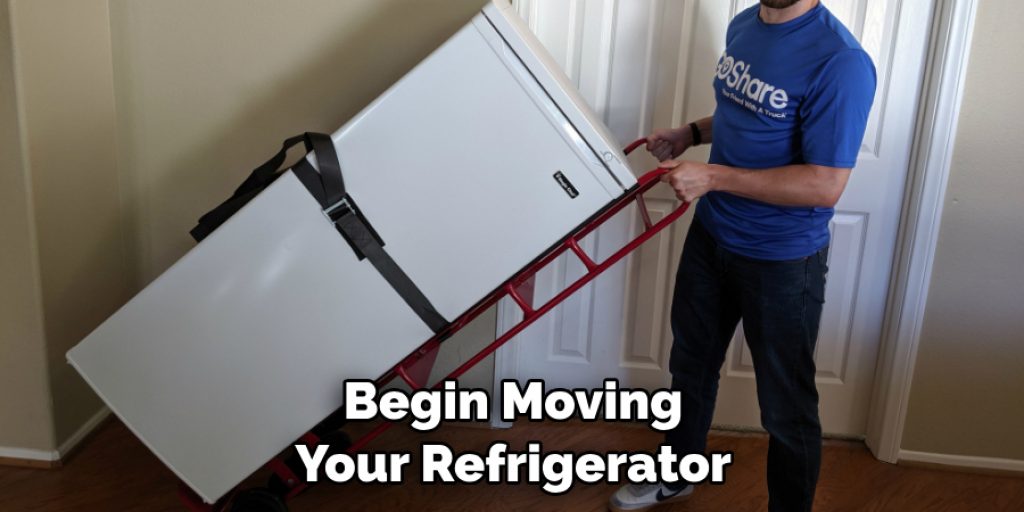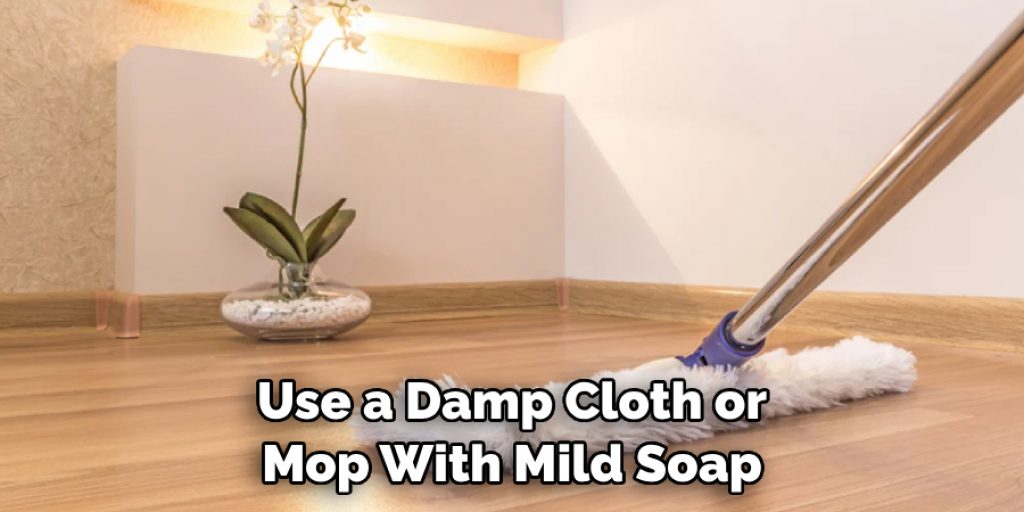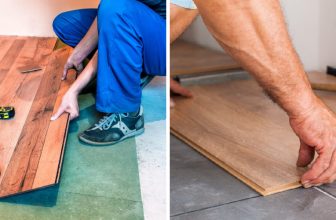How to Move Refrigerator Without Scratching Floor
Moving a refrigerator without scratching your floor can be a difficult task. With so many components that need to be handled carefully, it’s easy to become overwhelmed and make an expensive mistake in the process. That’s why we’ve created this guide on how to move a refrigerator without damaging your floors — complete with step-by-step instructions and useful tips for tackling the job safely.

The goal is to get you through this tricky chore as quickly (and safely) as possible, leaving your floors intact! So take a deep breath, read our helpful advice on how to move refrigerator without scratching floor and get ready to start moving your fridge around like a pro – let’s dive right in!
Needed Materials
Given the sheer size and weight of refrigerators, this task requires good preparation to avoid any damage or accidents. Here is a list of materials you’ll need before you start moving your refrigerator:
- Furniture Sliders or Thick Cardboard Pieces
- Cleaning Supplies (Mop or Vacuum)
- Measuring Tape
- Dolly
- Moving Straps or Rope
- Protective Gloves and Shoes
- Large Piece of Cloth or Blanket
11 Step-by-step Instructions on How to Move Refrigerator Without Scratching Floor
Step 1: Empty the Fridge
Before you begin moving your refrigerator, make sure to empty out all the contents. This includes any food items, shelves, and drawers. Not only will this make the fridge lighter to lift, but it will also prevent any spills or accidents during the move. It’s also a good idea to defrost the freezer beforehand, as this will reduce the weight of the fridge and prevent any water from leaking onto your floors.

Step 2: Unplug and Disconnect
Once you’ve emptied out the refrigerator, unplug it from the power source. If there is a water supply line connected to your fridge, make sure to disconnect it as well. This will prevent any potential water damage during the move. It’s also important to shut off the water supply valve before disconnecting the line.
But if you’re unsure how to do this, it’s best to call a professional. You don’t want to cause any damage to your fridge or floors. It’s also a good idea to tape the power cord and water line to the fridge to prevent them from getting tangled or caught during the move.
Step 3: Measure and Plan Your Route
Before you start moving your refrigerator, measure the dimensions of your fridge and the doorways it needs to pass through. This will help you plan a safe and efficient route for moving the fridge without damaging any walls or door frames. It’s also a good idea to remove any obstacles from the route beforehand, such as rugs or furniture.
Although refrigerators are heavy and difficult to maneuver, having a clear path will make the task much easier. You can also use furniture sliders or thick cardboard pieces to protect your floors from any scratches as you move the fridge.
Step 4: Prepare the Floor
Place furniture sliders or thick cardboard pieces under the fridge to protect your floors from scratches. If you don’t have these materials, you can also use a large piece of cloth or blanket. It’s important to use a material with a smooth surface that will easily glide along the floor.
Avoid using materials like towels or cardboard boxes as they may leave behind small pieces and cause scratches. But whatever material you choose, make sure it completely covers the area where the fridge will be placed.
Step 5: Tilt and Slide
With the help of another person, tilt the refrigerator at an angle towards one side and place the dolly underneath. Slowly slide the fridge onto the dolly, making sure it is secure and balanced. It’s important to keep the fridge tilted at an angle to prevent any damage to the compressor or cooling components.

Once the fridge is securely on the dolly, you can begin moving it towards your planned route. You can also use moving straps or rope to secure the fridge onto the dolly for extra stability.
Step 6: Secure with Moving Straps or Rope
Once the refrigerator is on the dolly, secure it in place using moving straps or rope. This will prevent the fridge from falling over during transport and causing damage to your floors. It’s important to make sure the straps or rope are tightly secured and that they don’t get caught on any furniture or door frames as you move. But be careful not to tighten them too much, as this could damage the fridge.
Step 7: Move Slowly and Steadily
When moving the refrigerator, make sure to go slow and steady. Avoid any sudden movements or sharp turns, as this can cause the fridge to tip over and damage your floors. However, if you do encounter any tight spaces or corners, make sure to use extra caution and have someone guide you through.
It’s also a good idea to take breaks during the move to prevent any strain on your back or arms. It’s better to take your time and move the fridge safely, rather than rushing and potentially causing damage. Though it may be a slower process, your floors will thank you!
Step 8: Use a Ramp for Stairs
If you need to move the fridge up or down stairs, use a ramp instead of lifting it manually. This will ensure a smooth and safe transition without any damage to your floors. It’s important to have someone assist you during this process, as ramps can be tricky to navigate alone.
Make sure the ramp is secure and stable before moving the fridge across it. Otherwise, the fridge may tip over and cause damage. You can also use furniture sliders or cardboard pieces on the stairs to protect the edges from any scratches.
Step 9: Clean Along the Way
As you move the refrigerator, make sure to clean up any spills or debris that may have accumulated on the floor. This will prevent any accidents or slips during the move. It’s also a good idea to clean the area where the fridge will be placed before setting it down.
This will ensure a clean and level surface for your fridge to rest on, preventing any potential damage. But be careful not to use any harsh chemicals that may damage your floors. This step may seem small, but it can make a big difference in preventing scratches and damage to your floors.

Step 10: Roll Off the Dolly and Lower Gently
Once you’ve reached your desired location, carefully roll the refrigerator off the dolly and lower it onto the floor. Make sure to do this slowly and gently to avoid any sudden impacts that may cause damage to your floors. It’s also important to make sure the refrigerator is in its designated spot and level before plugging it back in. If necessary, use furniture sliders or cardboard pieces under the fridge to adjust their position without scratching the floor.
And with that, you have successfully moved your refrigerator without leaving a single scratch on your floors! Remember, taking the time to properly prepare for and execute the move will save you from any potential damage and headaches. So grab a friend and some materials to protect your floors, and follow these steps for a smooth and stress-free refrigerator move! Happy moving!
Step 11: Clean and Plug Back In
After you have successfully moved your fridge without scratching your floors, take a moment to clean up any marks or debris left behind. Then, plug the refrigerator back in and let it sit for a few hours before stocking it with food again. Always make sure to level the fridge and check for any potential leaks before fully restocking it.
Now that you’ve successfully moved your refrigerator without damaging your floors, sit back and relax knowing that your fridge is safely in its new location. Remember to always take precautions when moving heavy appliances and follow these steps to avoid any costly accidents or damage. Cheers to a job well done!
So, these were the steps on how to move refrigerator without scratching floor. With a little patience and preparation, you can successfully move your refrigerator to its new location without any scratches or damage to your floors. Happy moving!

Frequently Asked Questions
Q: Can I Move the Refrigerator by Myself?
A: It is not recommended to move a refrigerator by yourself as it can be heavy and difficult to navigate. It’s best to have at least one other person assist you during the move. It’s also important to have proper equipment, such as a dolly, to safely move the fridge.
Q: What If I Don’t Have a Dolly?
A: If you don’t have a dolly, you can rent or purchase one from a hardware store. Alternatively, you can use furniture sliders or cardboard pieces to slide the refrigerator across the floor. However, using a dolly is the safest and most efficient way to move a fridge without damaging your floors.
Q: Can I Use a Towel or Blanket to Protect My Floors?
A: While using towels or blankets may provide some protection, they can easily slip and cause damage to your floors. It’s best to use furniture sliders or cardboard pieces specifically designed for floor protection when moving heavy appliances like a refrigerator. Overall, investing in proper equipment and taking precautionary measures will ultimately save you from potential damage and costly repairs to your floors. So, it’s worth the extra effort!
Q: Can I Use Dish Soap or Water to Clean Up Spills?
A: It’s important to avoid using any harsh chemicals or excessive amounts of water when cleaning up spills during the move. This could cause damage to your floors or create a slip hazard.
Instead, use a damp cloth or mop with mild soap to gently clean up any spills or debris along the way. Keep in mind that prevention is key when it comes to protecting your floors during a refrigerator move. So, be mindful and take necessary precautions throughout the moving process.

Conclusion
We hope this guide has been of use to you in your refrigerator moving process! From looking at reviews before you purchase, to things like clearing a path and preparing your fridge for moving day, this guide has hopefully provided some valuable tips.
By following these steps on how to move refrigerator without scratching floor and being mindful of the damage a heavy refrigerator can do to your flooring, you can make sure your floors will stay unscathed as you move the refrigerator into its new home.
Remember, getting help from friends or family members is always a great idea when it comes to something as large and heavy as a refrigerator! Good luck in your future endeavors with your new appliance.




